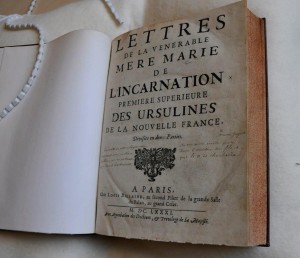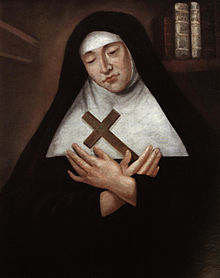Welcome to the introductory entry in a series of blog posts aiming to promote the rich North American collections at the IHR library. This month we focus on the highlights from our often overlooked Canadian holdings beginning with a selection of four works published before the British conquest of Canada in 1759/60. These books, all printed in France between 1681 and 1751, detail the early history of New France as well as the lives of several figures central to the establishment of the early religious and charitable institutions of 17th-century Quebec.
The first – and rarest – of the four is a 1681 Paris edition of Marie Guyart’s Lettres de la Venerable Mere Marie de L’Incarnation. It is one of two copies of this book housed in UK libraries (the other is held in the national collection at the British Library). The work is a collection of letters written by Marie Guyart (1599-1672) the first Mother Superior of the Ursuline Convent of Quebec. Born into an aristocratic family and widowed at 19, Guyart devoted her adult life to the service of the Catholic Church, becoming a member of the Ursuline Order of Tours in 1633. In 1639, Guyart, now Marie de L’Incarnation following her ordination as a nun, sailed to Quebec with several companions in order to reinforce the missionary efforts of the Jesuits in the colony. Upon arrival, they founded a convent for the purpose of educating Huron girls in the teachings of the Church. In its early years, the convent educated Indian women from the vicinity of Quebec and Montreal but gradually expanded its remit in the century after Guyart’s death to include girls from the settler community of New France. Many graduates went on to establish religious orders and institutions throughout Canada, including the convents of Trois Rivières and Roberval. Though, like many of Quebec’s buildings, the convent was damaged during Wolfe’s bombardment of the city in 1759, the order and the school survived the province’s transition to English rule. The school established by Guyart and her peers exists now as the École des Ursulines, a girls’ primary school attached to the original convent.
Like the Ursuline Convent, the Hôtel-Dieu of Quebec was an important institution in the new colony run primarily by women. The IHR library owns a rare copy of Jeanne-Françoise Juchereau’s four volume Histoire de l’Hôtel-Dieu de Quebec (Montauban [France], 1751). The Histoire de l’Hôtel-Dieu details the founding of the hospital and its role in the social welfare of New France during the colony’s turbulent early years. Juchereau was the Mother Superior of the Hôtel-Dieu from 1683 to 1707. She was heavily involved in colonial and imperial politics as a result of her position and found herself battling provincial governors and her Parisian superiors in her quest to secure money and resources for the hospital. She was renowned for her selfless commitment to her patients during the 1688, 1703 and 1711 influenza and measles epidemics. The hospital’s role in the treatment of the sick and destitute during these periods of crisis feature heavily in the Histoire. Along with the Lettres of Marie Guyart, the Histoire reveals the centrality of women in the establishment and maintenance key social institutions in 17th-century Quebec.
 Finally, the IHR owns two early histories of French Colonization in North America. The first, the Histoire de l’Amerique Septentrionale (Paris, 1722) by Claude-Charles Bacqueville de la Potherie, examines the history and culture of the Iroquois Indian Nation and its relationship with French settlements along the St. Lawrence river. The second work, Pierre-Francois-Xavier de Charlevoix’s Histoire et description générale de la Nouvelle France (Paris, 1744), also describes the history of New France, though it places greater emphasis on the environmental factors that shaped colonial development. Charlevoix emphasizes the natural resources of territories of Canada and Louisiana, often with an eye on their usefulness for Europeans. Charlevoix was a Jesuit priest who travelled extensively throughout North America in an unsuccessful mission to reach the Pacific Ocean via intercontinental waterways. Interestingly given the works discussed above, he was moved to write a biography of Marie Guyart as an act of thanksgiving following the wreck of his ship off the coast of Florida in 1722. Based upon notes from Charlevoix’s extensive travels as well as twenty years of research in Paris, the Histoire et description générale represents an early attempt to synthesize a description of the natural resources and ecology of the North American interior with a history of New France.
Finally, the IHR owns two early histories of French Colonization in North America. The first, the Histoire de l’Amerique Septentrionale (Paris, 1722) by Claude-Charles Bacqueville de la Potherie, examines the history and culture of the Iroquois Indian Nation and its relationship with French settlements along the St. Lawrence river. The second work, Pierre-Francois-Xavier de Charlevoix’s Histoire et description générale de la Nouvelle France (Paris, 1744), also describes the history of New France, though it places greater emphasis on the environmental factors that shaped colonial development. Charlevoix emphasizes the natural resources of territories of Canada and Louisiana, often with an eye on their usefulness for Europeans. Charlevoix was a Jesuit priest who travelled extensively throughout North America in an unsuccessful mission to reach the Pacific Ocean via intercontinental waterways. Interestingly given the works discussed above, he was moved to write a biography of Marie Guyart as an act of thanksgiving following the wreck of his ship off the coast of Florida in 1722. Based upon notes from Charlevoix’s extensive travels as well as twenty years of research in Paris, the Histoire et description générale represents an early attempt to synthesize a description of the natural resources and ecology of the North American interior with a history of New France.
The next blog entry, due out next week, will focus on immigrant experiences in 19th-century Canada and will examine a varied selection of sources from the library including handbooks for travelers and emigrants, published letter collections and immigrant journals. I look forward to sharing the stories of these men and women with you. À la prochaine fois!

